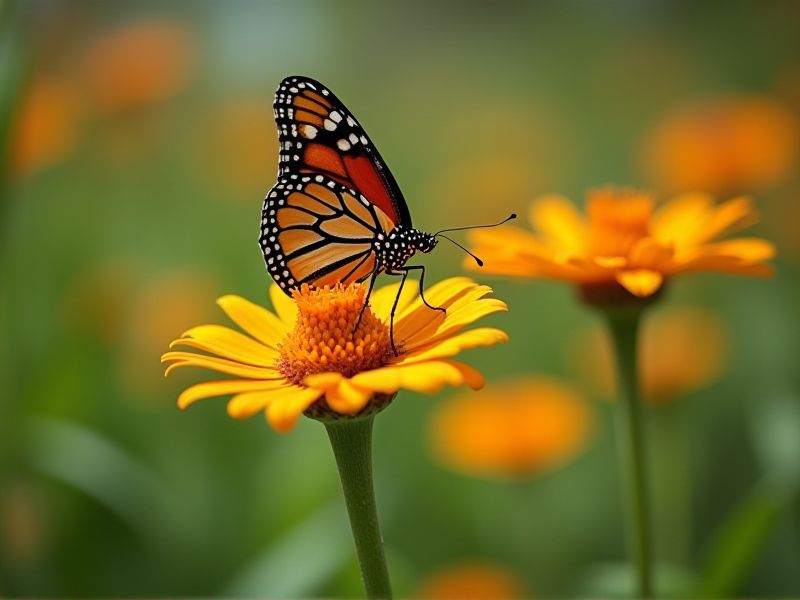
Butterfly-friendly plants are essential for creating a vibrant and sustainable garden. Nectar-rich flowers such as coneflowers, milkweed, and lantana attract various butterfly species, providing them with nourishment. Introducing host plants like parsley, dill, and milkweed ensures that butterflies can lay eggs, supporting their life cycle. Selecting native plants not only enhances the local ecosystem but also fosters a familiarity for butterflies in your area. Create a diverse planting scheme, including sunny spots and sheltering areas, to encourage these beautiful insects to thrive in your garden.
List of some Butterfly-friendly plants that bloom
- Butterfly Bush (Buddleja davidii)
- Coneflower (Echinacea purpurea)
- Milkweed (Asclepias spp.)
- Lantana (Lantana camara)
- Joe-Pye Weed (Eutrochium purpureum)
- Zinnia (Zinnia elegans)
- Black-eyed Susan (Rudbeckia hirta)
- Aster (Symphyotrichum spp.)
- Verbena (Verbena spp.)
- Coreopsis (Coreopsis spp.)
Important things about Butterfly-friendly plants that bloom
Nectar-Rich Flowers
Butterfly-friendly plants that bloom throughout the seasons can significantly enhance your garden's appeal while supporting local ecosystems. Selecting nectar-rich flowers such as milkweed, black-eyed Susan, and lantana attracts various butterfly species, providing them with essential food sources. Incorporating flowering plants that bloom at different times ensures a constant supply of nectar, keeping butterflies nourished from spring through fall. By creating a diverse garden with these vibrant blooms, you not only beautify your space but also promote biodiversity and foster a thriving butterfly population.
Brightly Colored Blooms
Butterfly-friendly plants are essential for creating vibrant gardens that attract and nourish these beautiful insects. Consider incorporating milkweed, which is a crucial host plant for monarch caterpillars, along with coneflowers that provide nectar for a variety of butterfly species. Planting lantana can also enhance your garden, as its clusters of brightly colored flowers draw butterflies and other pollinators. By selecting a range of flowering plants that bloom at different times, you can ensure a steady supply of food for butterflies throughout the growing season.
Native Plant Preference
Choosing butterfly-friendly native plants can significantly enhance your garden's appeal and ecological health. Plants such as milkweed, coneflower, and black-eyed Susan not only attract butterflies but also provide essential nectar sources for various species throughout their life cycles. Incorporating a diverse range of blooming times ensures there's something for butterflies to feed on from spring to fall, maximizing local biodiversity. By selecting plants that are native to your region, you create a sustainable habitat that supports pollinator populations and enriches your outdoor space.
Long Blooming Season
Butterfly-friendly plants with a long blooming season are essential for attracting these pollinators to your garden. Species like lantana, milkweed, and coneflower provide nectar from spring through fall, ensuring a continuous food source for butterflies. Native plants such as aster and bee balm not only support local butterfly populations but also enhance biodiversity in your landscape. By incorporating a variety of these plants, you create a vibrant garden that flourishes year-round, inviting butterflies to thrive and contribute to a healthy ecosystem.
Varied Flower Shapes
Butterfly-friendly plants often feature varied flower shapes that attract these pollinators with their visual appeal and nectar-rich profiles. Plants such as coneflowers, with their distinctive cone-shaped centers, and zinnias, known for their vibrant, flat blooms, provide ample landing spaces for butterflies to forage. Additionally, tubular flowers like trumpet vine offer an ideal feeding station for long-tongued butterfly species, which are drawn to their deep nectar reservoirs. When you choose a diverse array of flowering plants in your garden, you enhance the aesthetic beauty and contribute to local butterfly populations.
Plants With Host Leaves
Butterfly-friendly plants that bloom often feature host leaves essential for caterpillar development, ensuring a thriving butterfly population in your garden. Milkweed, for instance, serves as a crucial host for Monarch butterflies, providing nourishment for their larvae. Additionally, fennel and parsley are excellent choices for the Swallowtail butterfly caterpillars, attracting these beautiful pollinators to your outdoor space. Incorporating these plants not only supports butterfly life cycles but also enhances the beauty and biodiversity of your garden, making it a vibrant sanctuary.
Minimal Pesticide Use
Choosing butterfly-friendly plants that bloom in your garden not only enhances its beauty but also supports local ecosystems. Select native species such as milkweed, coneflowers, and lantana, as they attract various butterfly species while requiring minimal pesticide use. Incorporating these plants creates a safe haven for butterflies, encouraging them to lay eggs and thrive in your garden. By fostering a pesticide-free environment, you not only promote biodiversity but also enjoy vibrant blooms throughout the growing season.
Sunlight Requirements
Butterfly-friendly plants thrive best in full sun, requiring at least six hours of sunlight each day to produce vibrant blooms that attract butterflies. Species like milkweed, coneflower, and lantana are excellent choices for your garden, as they not only offer nectar for feeding but also serve as host plants for butterfly larvae. Positioning these plants in sunny spots will enhance their growth and flowering potential, creating a lively habitat for various butterfly species. Incorporating diverse blooming plants ensures a continuous supply of nectar throughout the growing season, supporting both adult butterflies and their caterpillars.
Drought Tolerance
Choosing butterfly-friendly plants that excel in drought tolerance is vital for garden biodiversity. Native species like milkweed, echinacea, and lavender hold significant appeal for butterflies while requiring minimal water once established. These plants not only attract various butterfly species but also contribute to the overall resilience of your garden against climate change. Incorporating such resilient flora can create a vibrant habitat that supports pollinators and conserves water resources effectively.
Pollinator-Friendly Practices
Butterfly-friendly plants, such as milkweed, coneflower, and lantana, play a crucial role in supporting local pollinator populations. These plants not only provide essential nectar sources but also serve as habitats for butterfly larvae, crucial for their life cycle. When you incorporate a variety of native flowering plants that bloom at different times throughout the growing season, you create a continuous food source for butterflies, ensuring their presence in your garden. By prioritizing the planting of these specific species, you enhance biodiversity and contribute to the overall health of the ecosystem.
